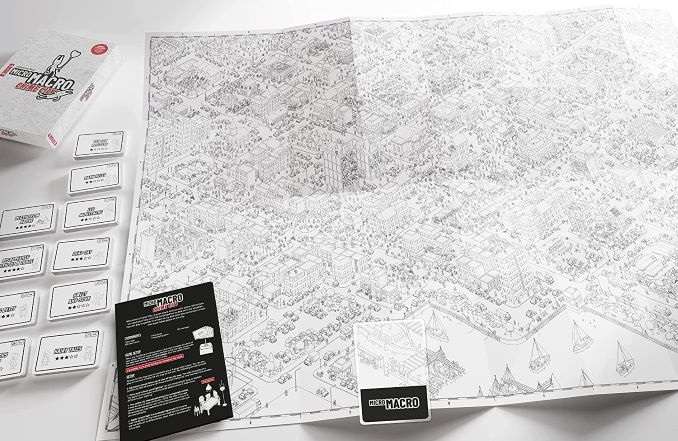MicroMacro Crime City Is a Fun Twist on the Puzzle Game
Images courtesy of Pegasus Spiele Games Reviews board games
MicroMacro Crime City won the Spiel des Jahres (Game of the Year) award in 2021, despite one of the most unappealing game titles I can remember—what on earth does “MicroMacro” even mean? Maybe it sounded better in the original German. LittleBig? TinyHuge? Whatever you think of the title, it’s a clever visual puzzle game that asks players to work together to find the solutions to 16 cases by examining the game’s giant fold-out map.
The city of the game’s title is a violent one, filled with cartoon characters getting drunk, robbing banks, and killing each other. Imagine a giant Richard Scarry cartoon, in black and white, where, instead of going about their regular business of buying groceries and commuting to work, various leporine cartoon characters are face down in alleys, sometimes in pools of blood, or engaging in drive-by shootings where gang members take revenge on street toughs. Forget it, Jake. It’s not Busytown.
The game comes with 16 separate cases that all ask you to find a series of clues on the giant map, which depicts the big city with various buildings, vehicles, and its denizens. Those characters appear multiple times across the map, representing their movement over a period of time, so that you can follow their trails to try to solve the crime involving that character. Each case file has a series of from five to eight cards that present you with questions to solve, leading up to the final resolution of the case. The questions might point you to the beginning of the crime—two characters rob the city’s bank—and ask you to track the thieves’ flight from the city and find the hiding spot for the cash, or might point you to the character lying dead in the street and ask you to work your way backwards to figure out who killed them and why.

The map is huge but the art, while very precise, is small, so the game comes with a small magnifying glass to help. It’s a cooperative game that you could just as easily play solo, but with multiple players, you may want multiple methods to zoom in on the map. Often following a specific character means identifying them by a very minute feature, such as a very pointy nose or the unusual shapes of the tops of their heads; we played with five people, one more than the box recommends, and only the youngest (a teenager) could look at the map without any sort of help from glasses or a magnifier to find everything. (Alas, I have reached an age where I need glasses to read, a rather significant handicap for a professional writer person.)
The cases are quick to solve, as short as five minutes, increasing in difficulty as you move through the 16 cases in order. The cards tend a bit towards overexplaining things—we would often find ourselves jumping ahead because it was easy enough to find a future clue, or even the answer to the entire case, while in the process of finding answers to the intermediate questions the game provided. You could easily run through the entire set of cases in an evening if you decided to power through them one after another.
After the game was released, there was some pushback for the violent content in a game that, at least from the cover art, looks like it might be for kids. The art isn’t an issue at all, as none of the violence is graphic in the least. If there’s anything objectionable here, it’s the descriptions of the crimes on the case cards—but any sensible adult would just change the wording while reading the case descriptions aloud, right? The second set of cases, sold in a standalone game called MicroMacro Crime City: Full House, come with a parental warning for any cases that might include objectionable content, as do later printings of the original game, so I hope you’re happy now, Karen.
This is a one-and-done game—once you’ve played through the 16 cases, there’s no replay value here, although you can certainly pass it along to someone else, as you don’t need to mark or destroy any parts of the game to solve the cases. But it’s a fun twist on the puzzle game genre popularized by games like Chronicles of Crime or the Exit series, and the giant map makes the game very social because players can gather around it or examine different parts at once. The box suggests one to four players, with the upper bound primarily a function of how easy it is for people to look at one section of the map; I think it’d be best with two or maybe three, for the same reason. My guess is that this won the Spiel because of its novelty, even if it wasn’t really the best-designed game of 2021.
Keith Law is the author of The Inside Game and Smart Baseball and a senior baseball writer for The Athletic. You can find his personal blog the dish, covering games, literature, and more, at meadowparty.com/blog.